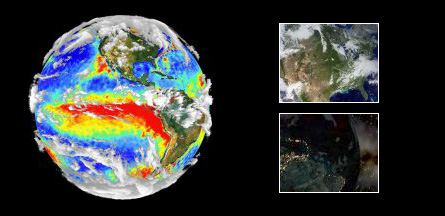NANTES, France — The first space-based observatories to find and study Earthlike planets won’t be able to image these bodies but will determine their composition by recording their spectra. Now a new study suggests that the telescopes may recognize a twin of Earth much quicker — in fact, in a twinkling.

As seen from space, Earth appears to vary its brightness, or twinkle, as different clouds in its atmosphere rotate in and out of view. The clouds are the main source of light reflected from Earth, notes Enric Pallé of the Institute of Astrophysics of the Canary Islands in Laguna, Spain.
Using 21 years of data from a network of weather satellites, Pallé and his colleagues show that Earth has a surprisingly stable global cloud pattern, despite large variations over short time and length scales. His team’s computer-generated model indicates that a distant extraterrestrial observer would see Earth as a point source of light that varies in brightness in a repeating, predictable pattern, just like spots on a spinning ball, Pallé says.
If an extrasolar Earth has a similarly stable cloud pattern, tracking the orb’s twinkling over several months may reveal how rapidly the planet rotates, and if the rotation varies. As seen from afar, the presence of clouds causes an apparent variation in Earth’s rotation. The existence of clouds in the atmosphere of a terrestrial extrasolar planet is therefore a tip-off for the probable presence of water and conditions possibly suitable for life. Deviations from a purely periodic signal may indicate the presence of an active weather pattern. Earth-sized planets that don’t twinkle are less likely to be habitable, Pallé’s team notes.
The same criteria would also hold true for superEarths, he notes, provided that they have similar cloud and surface features.
Pallé presented the findings June 17 during a conference on superEarths — extrasolar planets that are about five to 10 times as massive as Earth.
Wes Traub of NASA’s Jet Propulsion Laboratory in Pasadena, Calif., notes that the twinkling would be even more pronounced at infrared wavelengths, where the planet would be brighter and therefore easier to pick out from the brilliant light of its parent star.







